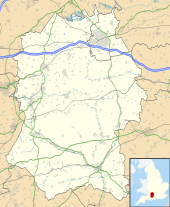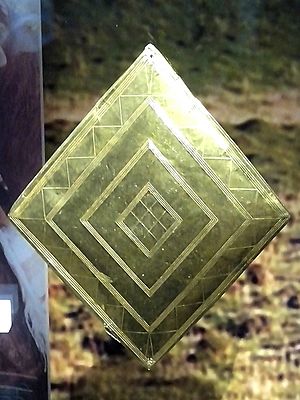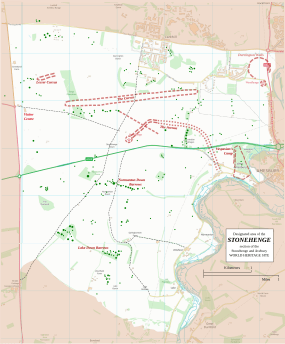Normanton Down Barrows facts for kids

Round barrow on Normanton Down
|
|
| Coordinates | 51°10′12″N 1°49′48″W / 51.170°N 1.830°W |
|---|---|
| Type | Round barrow cemetery |
| Part of | Stonehenge ritual landscape |
| Length | 1km |
| History | |
| Periods | Bronze Age |
| Site notes | |
| Excavation dates | 18th and 19th centuries |
| Archaeologists | William Cunnington and others |
| Ownership | Part is managed as RSPB Reserve |
| Public access | Crossed by two bridleways |
| Official name | Stonehenge, Avebury and Associated Sites |
| Type | Cultural |
| Criteria | i, ii, iii |
| Designated | 1986 (10th session) |
| Reference no. | 373 |
| Region | Europe and North America |
| Designated | 1925 |
| Reference no. | (west to east): 1009617, 1009618, 1009614, 1009615, 1009616, 1010330 |
Normanton Down is an ancient burial ground located near Stonehenge in Wiltshire, England. People were buried here between 2600 and 1600 BC. This site has one very old 'long barrow' from the Neolithic (Stone Age) and over 40 'round barrows' from the Bronze Age. It sits on top of a small hill, about 1 kilometer south of Stonehenge.
Contents
Digging Up the Past: Excavations
The burial mounds at Normanton Down have been a part of the landscape near Salisbury Plain for thousands of years. You can even see them from Stonehenge!
In the 1700s and 1800s, digging up these burial mounds was a popular hobby for people interested in history. They were sometimes called "barrow-diggers." In 1808, two important archaeologists, William Cunnington and Sir Richard Colt Hoare, dug into several of these mounds. One of their most important discoveries was the Bush Barrow.
Most of these mounds are from the Bronze Age. However, some parts, like the long barrow, are even older, dating back to the Stone Age. Cunnington and Hoare found four groups of human remains close together in the east end of the long barrow. Unlike many early diggers, Hoare wrote a detailed report about what they found in 1812.
South of the long barrow, there was once a rectangular area called a 'mortuary enclosure'. This Stone Age earthwork has now been flattened by farming. It was first discovered using aerial photography in 1959.
Protecting the Site
To protect these important historical sites, many of the mounds were made 'scheduled monuments' in 1925. This means they are legally protected. In 1987, the area became part of a World Heritage Site. This made it even harder to dig there.
Because of these rules, recent studies have focused on looking at old finds again. They also use methods that don't involve digging, like surveys. In 2007, researchers from the University of Birmingham started studying objects from all British Bronze Age burials, including those from Bush Barrow. In 2010, English Heritage did a big survey of the mounds. This was part of their project to understand the Stonehenge World Heritage Site better.
Bush Barrow: A Special Burial Mound
The most famous burial mound at Normanton Down is called Bush Barrow. It is about 40 meters wide and 3 meters high. William Stukeley gave it the name "Bush Barrow" in the 1720s because of the trees planted on its top. Before that, it was known as "the green barrow" for the same reason.
William Cunnington and Sir Richard Colt-Hoare dug into Bush Barrow in 1808. They found many amazing objects inside. Cunnington wrote a detailed report about finding a body and the objects around it. He noted that the body was placed on the ground, not in a pit, which was unusual. He also described pieces of metal and wood. Today, experts believe these were parts of a rare type of dagger or knife. Modern studies suggest that the objects were placed very carefully around the body.
Here is a small part of Cunnington's own notes: "When we reached the bottom of the mound, we found the skeleton of a strong, tall man. It was lying from south to north. About 18 inches south of his head, we found several brass (which means bronze) rivets mixed with wood. These items covered a space of 12 inches or more; they were probably the remains of a shield. Near his right arm was a large bronze dagger and a bronze spearhead, which was 13 inches long. This was the largest we had ever found.
Right over the skeleton's chest was a large gold plate, shaped like a diamond. It measured 7 inches by 6 inches. This beautiful ornament has lines, checks, and zigzags carved into it, forming diamonds within diamonds. Next, on the right side of the skeleton, we found a very interesting stone with a hole in it. We also found some carved bone items, many small bone rings, and another gold diamond shape. This stone doesn't show signs of being used every day. Because it is made of many tiny sea creatures, we think it was a very important object."
The objects found at Bush Barrow are now on display at the Wiltshire Museum in Devizes. The museum also keeps Cunnington's original notes and drawings.
Why Normanton Down is Important
The types and number of valuable objects found at Normanton Down suggest it was a burial place for very important people. Many burials show that people were buried with great care. For example, important men found with daggers were placed lying on their left side. These men were likely leaders who carried daggers in their daily lives.
The location of Normanton Down itself also shows it was a special burial site. It was chosen because it has clear views of Stonehenge and other hilltops in almost every direction. It also lies on the same special line as Stonehenge, which lines up with the sun's position at certain times of the year.
Studies of Normanton Down have also shown that there was very little flint-working (making tools from flint stone) happening there. This is different from the areas right around it. This suggests that the site was kept separate from everyday activities. It likely had a very special meaning to the people who used it.
Compared to other similar burial grounds, Normanton Down has an unusually high number of 'disc barrows'. It also has several 'bell barrows' and one 'saucer barrow'.




